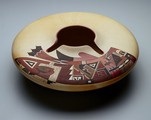
 |
Dextra Quotskuyva |
Look
- What is this object? How can you tell? Of what material is this jar
made? How can you tell? Where does clay come from? Do the colors look
natural or artificial? Why do you say that?
- How do you think the artist made this jar? This jar was made by hand
with long coils of clay. How do you think the artist made it look so
smooth? What tools might she have used? How do you think this jar would
feel if you were to touch it?
- What is PATTERN?
Describe the patterns you see on this jar. Where on this jar do you
see shapes or lines repeated to create patterns? How does the artist
use color to create patterns? What GEOMETRIC
shapes can you see on this jar? Where do you see ORGANIC
shapes on this jar? Which shapes look both organic and geometric? Are
there more geometric or organic shapes? What about the shape of the
jar itself?
- Designs can be REPRESENTATIONAL,
ABSTRACT,
or a combination of both. Which elements in this design do you consider
representational? Which ones do you consider abstract? Is the design
primarily representational or abstract? How do you think the artist
made this design? What tools might she have used?
- How does the decoration on one section of the jar emphasize that section?
How does this contribute to the overall balance of the jar? Do you think
the design is balanced? Why do you say that?
Think
- What kinds of work were involved in making this jar? (Gathering clay,
mixing in temper, coiling, scraping, sanding, polishing, firing.)
- How do you think this Hopi-Tewa artist learned to make and decorate
pottery? What skills have you learned from other people? What skills
have you taught yourself by looking at examples made by others?
- The Hopi-Tewa people continue to make pottery in the tradition of
their grandmothers and great-grandmothers. What is a tradition? Do you
have traditions in your family that you can trace back to your ancestors?
Why would it be important for people to have traditions that continue
through generations of a family? What are some ways that you think traditions
are passed from one generation to another?
- Hopi-Tewa artists make and decorate pots for use and for sale to tourists.
Why would a Hopi-Tewa artist take the time to decorate a pot with traditional
designs for tourists? If you were going to buy a piece of pottery from
a culture other than your own, would it be important to you that it
look "authentic" or traditional? Why or why not? Why do you think it
would be important to an artist working today to make traditional art
of his or her culture?
- What sort of containers do you and your family use to keep your food
in? What are your containers made of? Why do you think the Hopi-Tewa
used clay to make this seed jar? Why would they decorate a container
that was only used to hold seeds? What would you keep in this jar? Do
you have a special container to hold something that is important to
you? What do you keep in it? If you were going to make a special container
for yourself, how would you make and decorate it? What materials would
you use? What colors would you use?
- Compare this jar to the Greek Hydria. In what ways does each work
reflect the environment of the people who made it? What do the materials
and decorations tell you about the culture from which the work came?
![]()
Key ideas.
Where does it come from?
What does it look like?
How was it used?
How was it made?
Discussion questions.
Additional resources.
Select another piece.